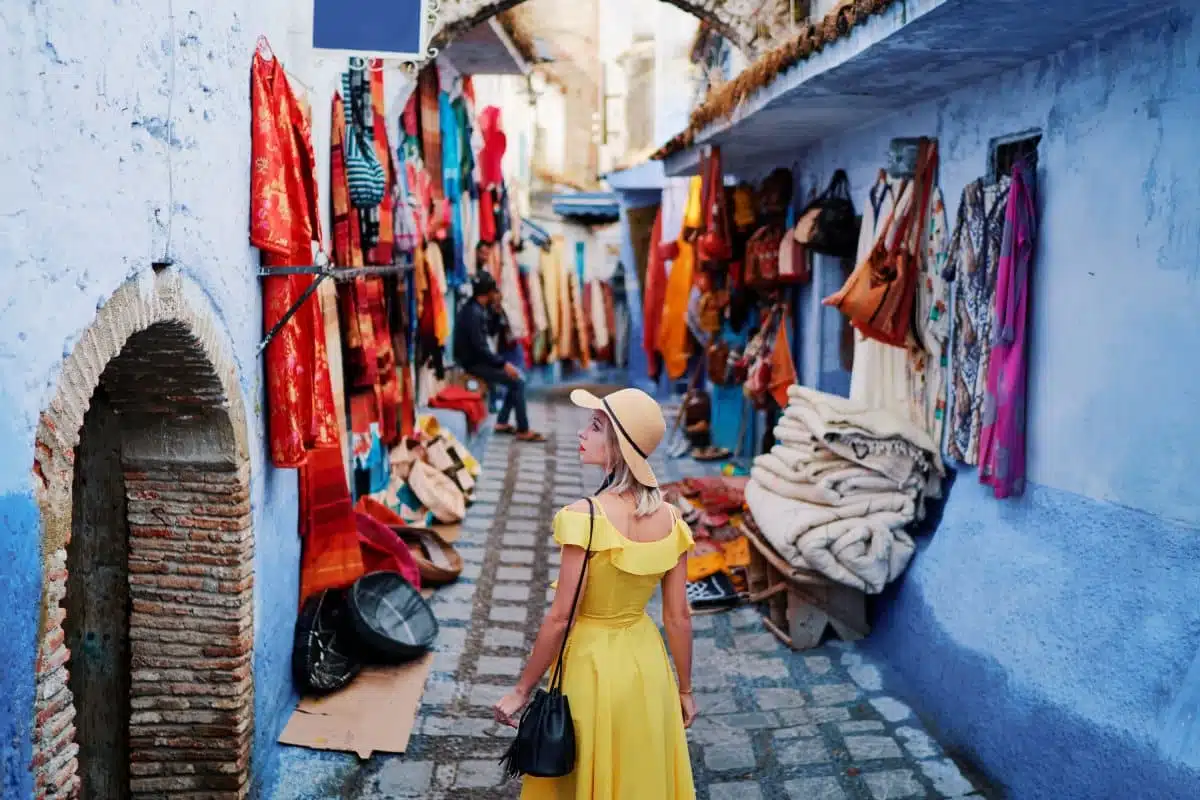Morocco, where the Atlantic Ocean meets the Mediterranean Sea, has diverse landscapes, a rich history, and a vibrant culture. From bustling medinas and majestic mountains to serene deserts and picturesque coastal towns, Morocco offers an array of experiences that cater to every type of traveler. This guide explores the heart of Morocco’s most captivating attractions, providing an insider’s perspective on what to see, do, and explore.
1. Explore Marrakech’s Medina
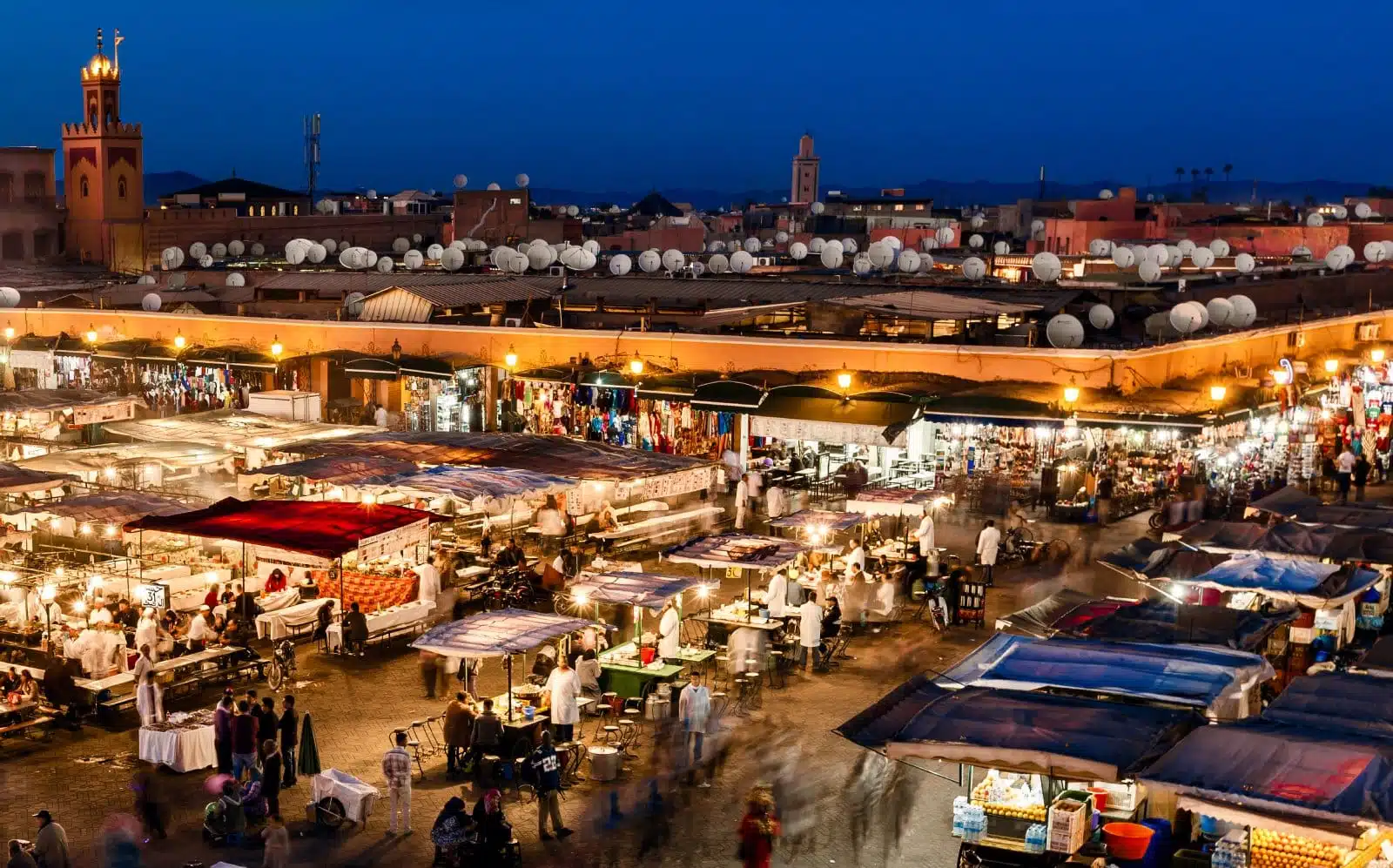
Image Credit: Shutterstock / cdrin
Marrakech’s Medina, a labyrinth of history and culture, highlights Morocco’s rich past. Within its ancient walls, the Medina houses a myriad of narrow alleys and bustling souks that offer an array of traditional Moroccan goods, from spices and textiles to intricate metalwork and leather goods. The heart of the Medina is the famed Jemaa el-Fnaa square, a UNESCO World Heritage site, where the air is filled with the sounds of musicians, storytellers, and snake charmers, creating a lively atmosphere that captivates both locals and visitors. Landmarks such as the Koutoubia Mosque, the impressive minaret, and the Bahia Palace, which showcase exquisite Islamic and Moroccan architectural styles, are essential visits. Walking through the Medina, you encounter the vibrant spirit of Marrakech, from hidden gardens to traditional hammams, inviting you to explore the city’s enchanting cultural past.
Insider’s Tip: Consider hiring a local guide to fully appreciate the Medina’s charm. They can provide insights into the history and culture you might otherwise miss and help you navigate the maze-like streets.
When to Travel: The best time to visit Marrakech is spring (March to May) and fall (September to November) when the weather is pleasantly warm.
How to Get There: Marrakech is accessible by plane, with the Marrakech-Menara Airport serving international and domestic flights. The Medina is a short taxi ride from the airport.
2. Visit the Blue City of Chefchaouen
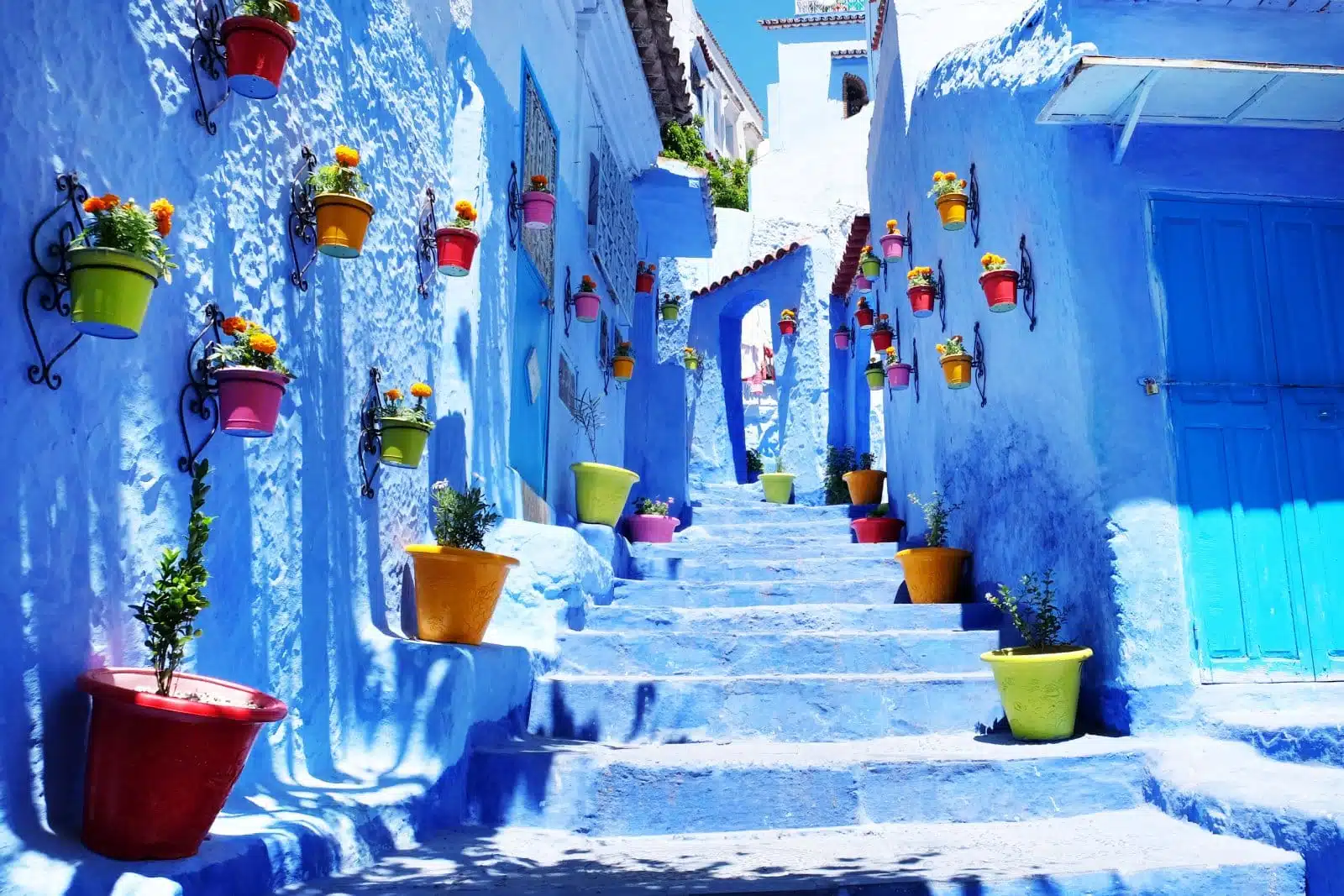
Image Credit: Shutterstock / Vixit
Chefchaouen, known as the Blue City, is a picturesque site in the Rif Mountains. Its blue-painted houses, a tradition that dates back to the 15th century, create a serene atmosphere that distinguishes Chefchaouen from any other Moroccan city. This tranquil town is a haven for photographers, artists, and those seeking a peaceful retreat from the hustle and bustle of larger cities. The narrow, cobbled streets lead to quaint plazas, local artisan shops, and cafes that offer a taste of the relaxed lifestyle of its inhabitants. The surrounding mountains provide a stunning backdrop and invite outdoor enthusiasts to explore the region’s natural beauty through hiking and trekking. Chefchaouen’s unique charm lies in its combination of natural beauty, historical significance, and cultural richness, making it a must-visit destination for those looking to experience the diversity of Morocco’s landscapes and the warmth of its people.
Insider’s Tip: Hike up to the Spanish Mosque before sunset for the best views of the town and its surrounding landscapes.
When to Travel: Spring (April to June) and fall (September to November) offer mild weather, ideal for exploring the town and its natural surroundings.
How to Get There: Chefchaouen can be reached by bus or private transfer from major cities like Tangier, Fes, and Rabat.
3. Experience the Sahara Desert
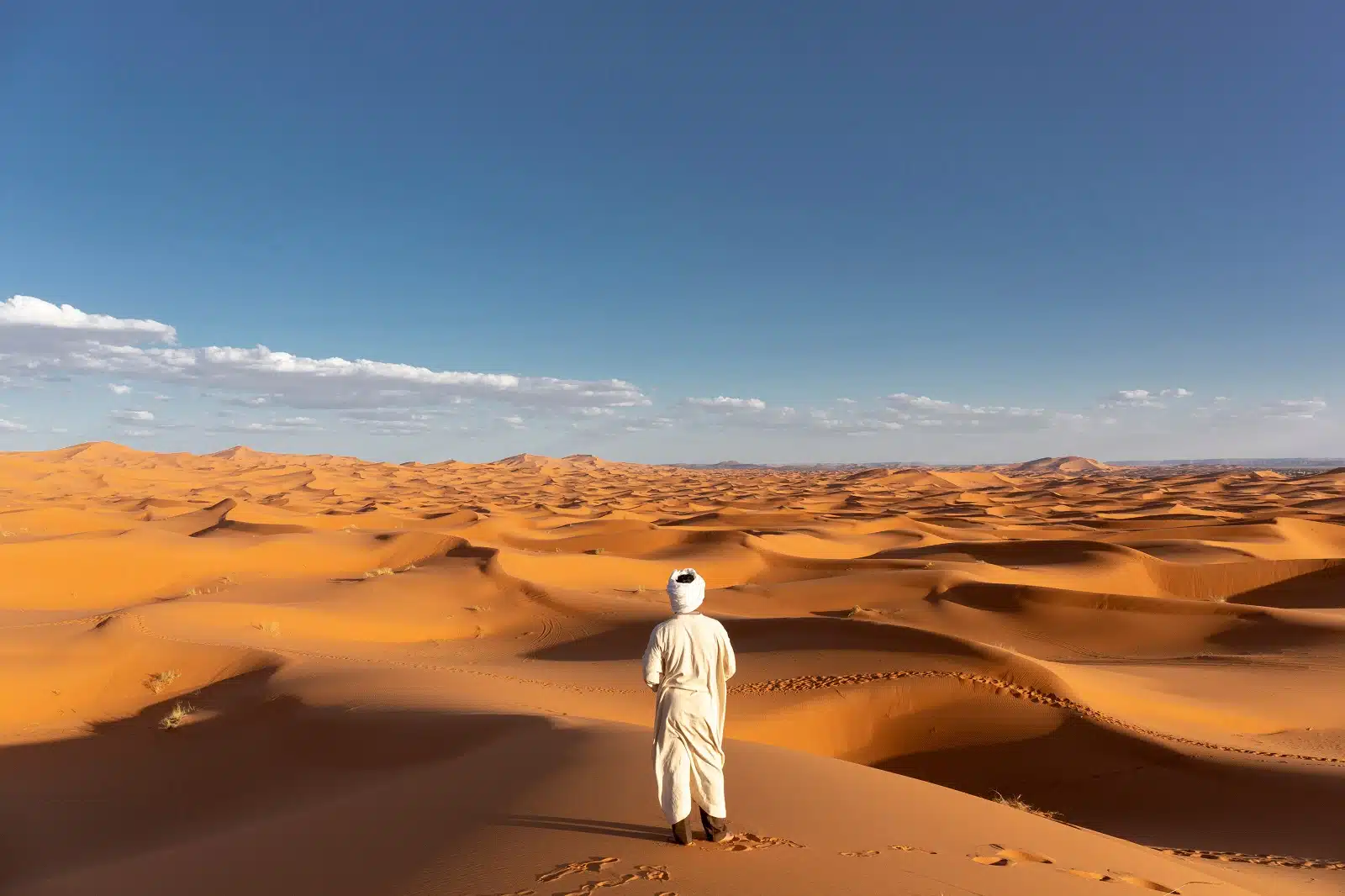
Image Credit: Shutterstock / Tjeerd Kruse
The Sahara Desert offers an adventure into the vastness of nature, where the endless dunes and starlit skies create an unforgettable landscape. Embarking on a camel trek through the desert, visitors experience the traditional mode of travel across this ancient terrain, leading to a night spent in a Berber camp. This experience provides a rare glimpse into the nomadic lifestyle, with traditional music and storytelling around the campfire under the vast desert sky. The Sahara is not just a desert; it’s a place of profound beauty and tranquility, where the silence is as impactful as the scenery. Witnessing the sunrise or sunset over the dunes is a moment of pure magic, where the colors of the sand shift with the light, offering a timeless spectacle. The Sahara Desert is a reminder of the earth’s natural wonders, providing a journey that is about inner reflection.
Insider’s Tip: Opt for a multi-day tour to fully immerse yourself in the desert experience, including visits to local Berber villages.
When to Travel: The best times to visit the Sahara are spring (March to May) and fall (September to November) when temperatures are more bearable.
How to Get There: The desert is accessible from several gateways, including Merzouga and M’Hamid. These towns are reachable by bus or private tours from Marrakech and Fes.
4. Discover Fes’ Old City
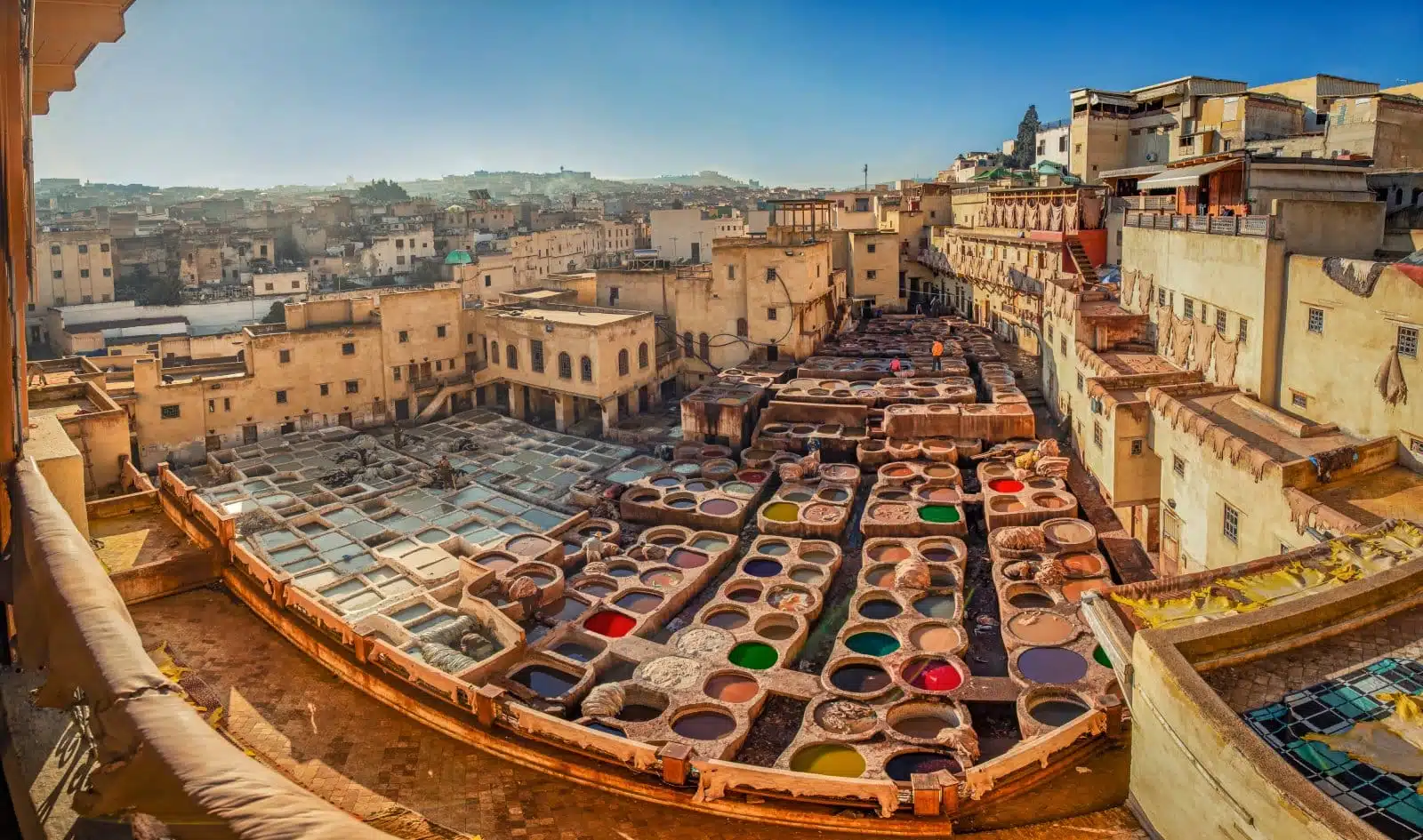
Image Credit: Shutterstock / Milton Louiz
Fes el Bali, the old city of Fes, is a living museum home to one of the world’s largest urban pedestrian zones. This ancient Medina, a UNESCO World Heritage site, is a labyrinth of over 9,000 narrow streets and alleys filled with historic madrasas, fondouks, palaces, and bustling markets. The city’s heart beats around the Al-Qarawiyyin Mosque and University, founded in the 9th century and recognized as the oldest continuously functioning university in the world. The Chouara Tannery’s vivid dye pits and traditional leather-making techniques highlight the city’s artisanal heritage. Fes el Bali’s architectural and cultural depth provides a profound insight into the Islamic civilization’s intellectual and spiritual dimensions. Exploring Fes is an immersive experience where the rich tapestry of Moroccan history, culture, and daily life unfolds before you, offering a journey back in time.
Insider’s Tip: Visit the tanneries early in the morning to see the dyeing process without the crowds.
When to Travel: Spring (March to May) and fall (September to November) are ideal for comfortable exploration.
How to Get There: Fes is served by the Fes-Saïss Airport, with the old city located about 30 minutes away by taxi.
5. Relax in Coastal Essaouira
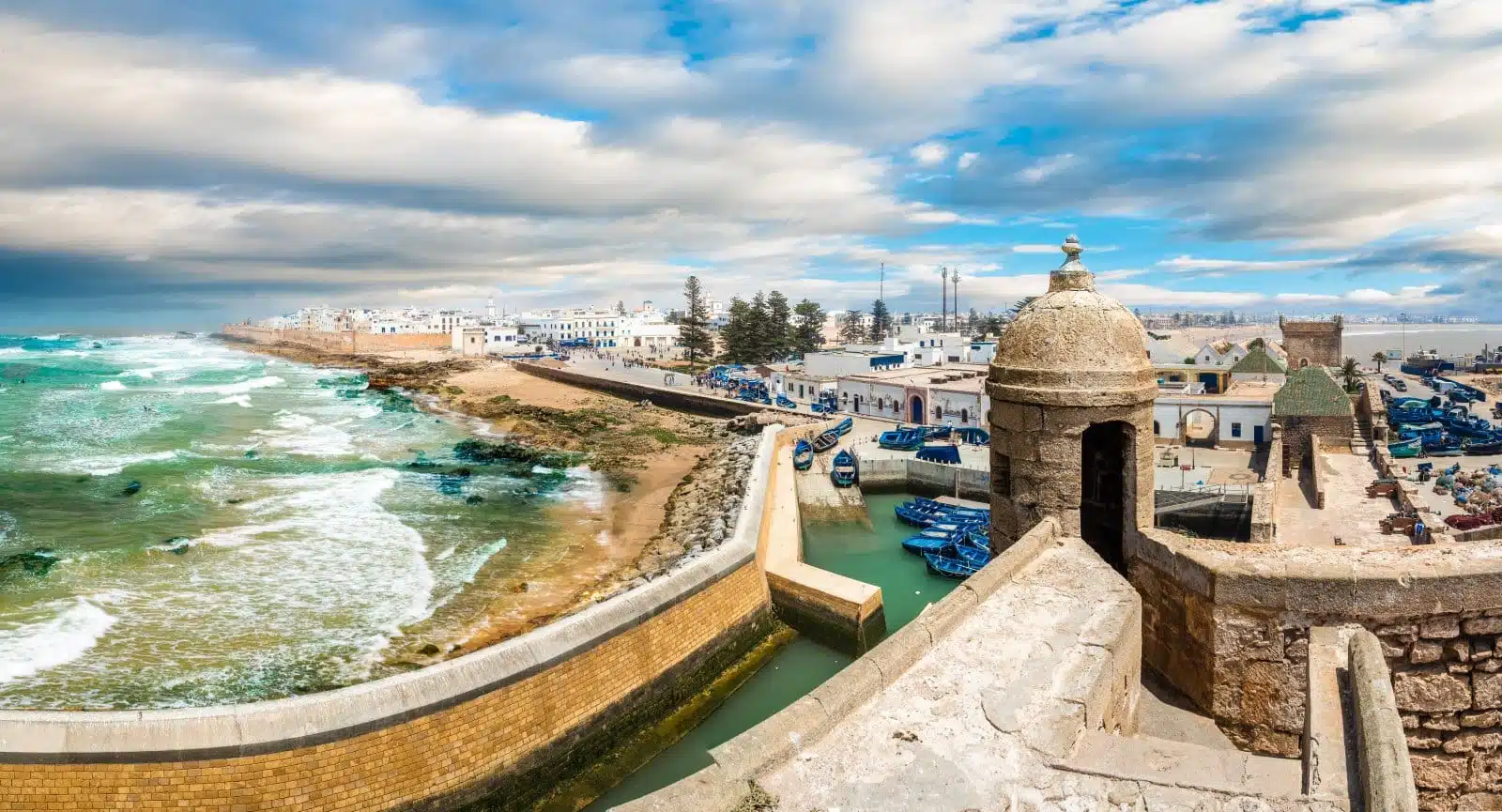
Image Credit: Shutterstock / Serenity-H
With its fortified walls and breezy Atlantic shores, Essaouira offers a picturesque escape that combines historical richness with natural beauty. This coastal city, once known as Mogador, is a UNESCO World Heritage site celebrated for its 18th-century architecture and vibrant cultural scene. The Medina, encircled by ancient ramparts, is a maze of artisan shops, galleries, and cafes where the relaxed pace of life is palpable. Essaouira’s port, bustling with fishermen and seagulls, provides a glimpse into the city’s maritime heritage. The wide, sandy beaches are a paradise for windsurfers and kitesurfers drawn by the consistent winds. Essaouira is a melting pot of cultures, reflected in its music, art, and cuisine, making it a place where history and modernity coexist harmoniously. Visiting Essaouira offers a blend of relaxation, adventure, and cultural discovery.
Insider’s Tip: For those interested in water sports, Essaouira is renowned for its excellent windsurfing and kitesurfing conditions, especially between April and November.
When to Travel: The best time to visit Essaouira is from April to November, when the weather is warm and conducive to outdoor activities.
How to Get There: Essaouira is accessible by bus from major cities like Marrakech and Casablanca. The town also has a small airport, Essaouira-Mogador Airport, serving limited domestic and international flights.
6. Hike in the Atlas Mountains
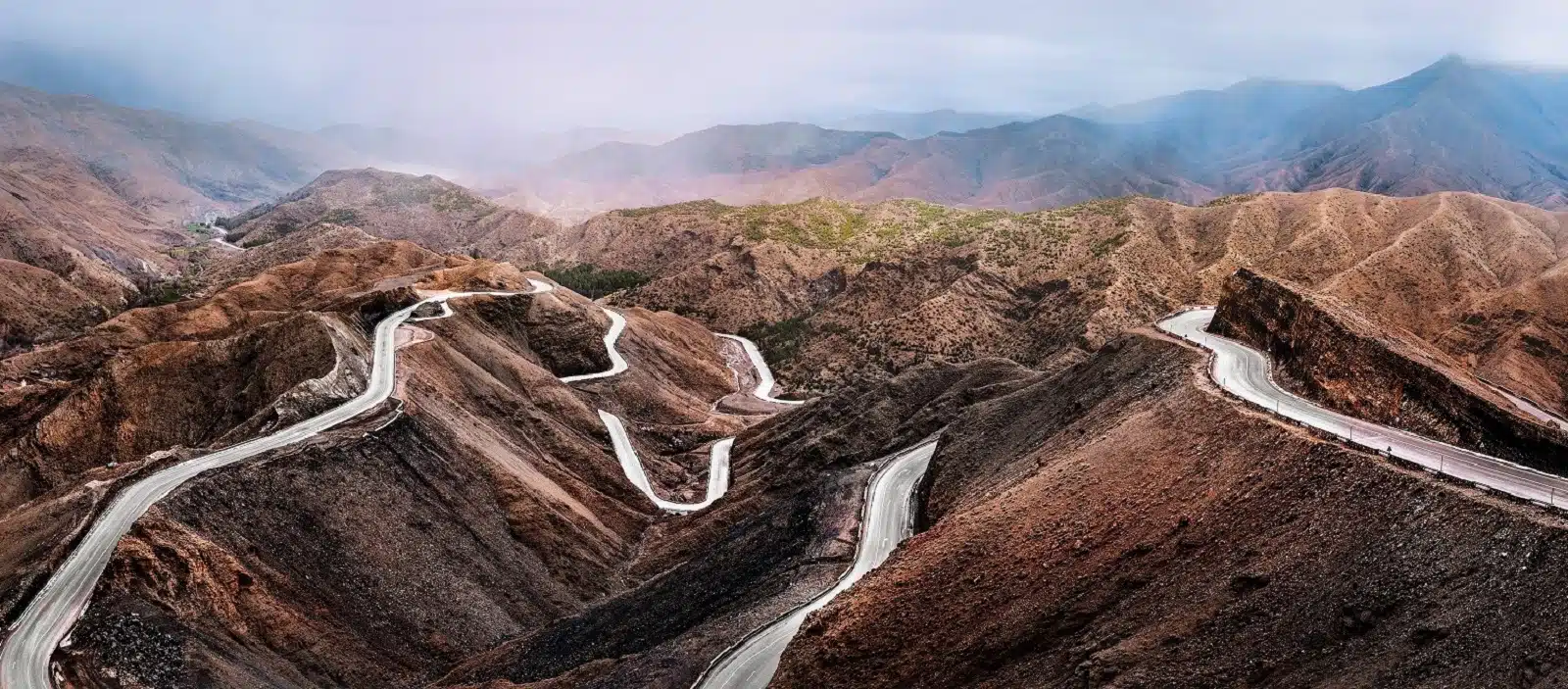
Image Credit: Shutterstock / SCP255
The Atlas Mountains, stretching across Morocco, offer an unparalleled natural landscape that invites exploration and adventure. This mountain range, home to Berber villages and diverse ecosystems, starkly contrasts the country’s urban centers. Trekking through the Atlas Mountains, visitors encounter majestic peaks, lush valleys, and traditional communities that maintain their ancestral ways of life. Climbing Toubkal, North Africa’s highest peak, presents a challenging yet rewarding experience, with panoramic views that stretch across the mountainous terrain to the Sahara Desert. The Atlas Mountains are not just a destination for hikers; they are a place of cultural immersion, where the hospitality and traditions of the Berber people offer a deeper understanding of Morocco’s heritage. The natural beauty and cultural richness of the Atlas Mountains make them a must-visit for those seeking adventure and connection with the natural world.
Insider’s Tip: Consider hiring a local guide for your trek. Not only will they provide valuable insights into the culture and environment, but they can also ensure your safety on the trails.
When to Travel: The best time for hiking in the Atlas Mountains is spring (April to June) and fall (September to October) when the weather is mild and the landscapes are most vibrant.
How to Get There: The Atlas Mountains are most commonly accessed from Marrakech, with Imlil as a popular starting point for treks to Toubkal.
7. Visit the Roman Ruins of Volubilis
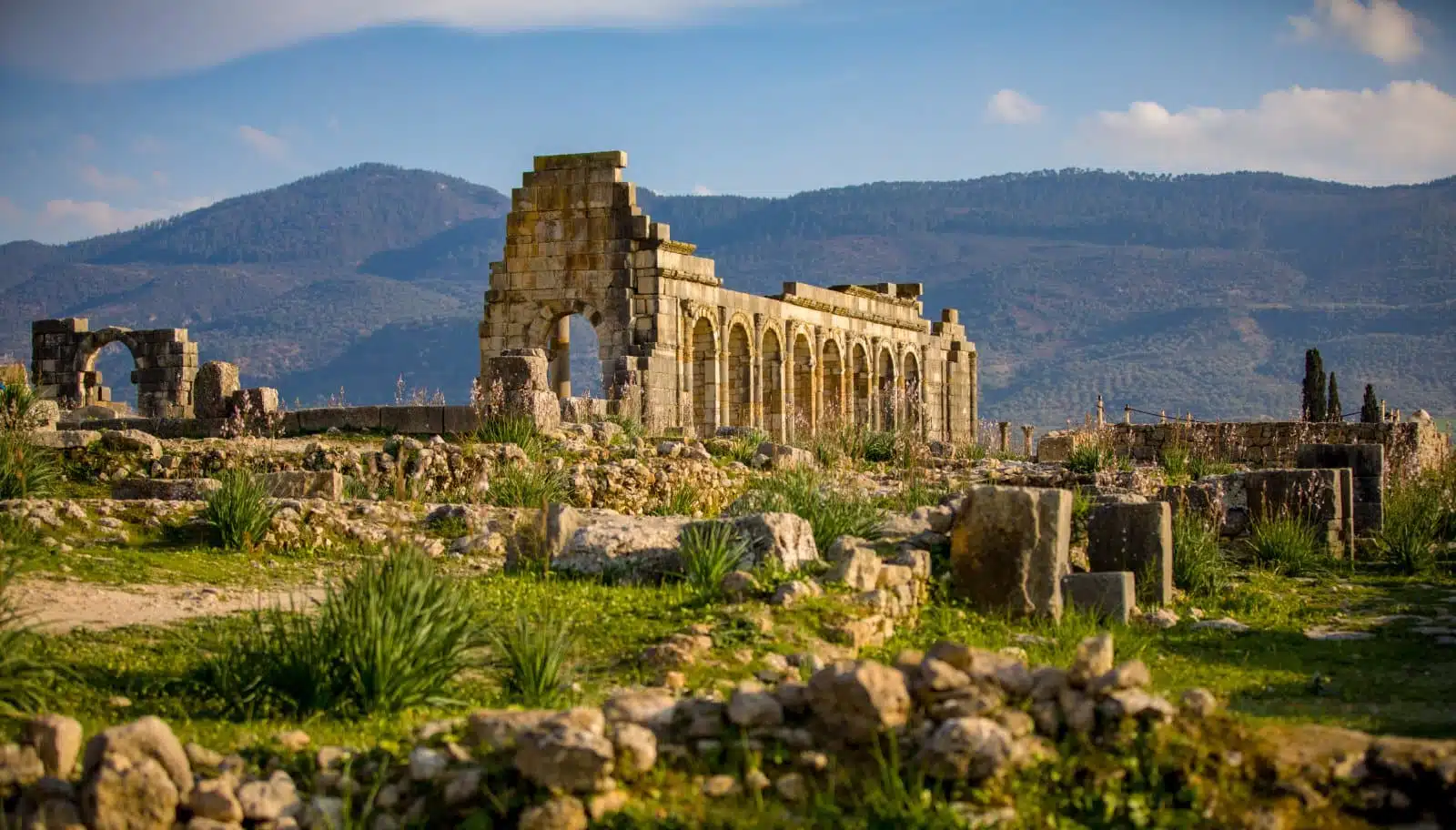
Image Credit: Shutterstock / Keeber
The Roman ruins of Volubilis, located near the sacred town of Moulay Idriss, are evidence of the ancient civilization that once thrived in Morocco. This UNESCO World Heritage site, one of the best-preserved archaeological sites in North Africa, offers a fascinating glimpse into Roman life. The ruins, set against a backdrop of rolling hills, include well-preserved mosaics, columns, and public buildings that speak to the city’s historical significance. Exploring Volubilis, visitors can walk along the Decumanus Maximus, the main street, and imagine the city’s bustling life in its heyday. The site’s highlights, such as the Basilica, the Triumphal Arch, and the House of Orpheus, showcase the architectural and artistic achievements of the Roman Empire. A visit to Volubilis is not just a journey into the past; it’s an opportunity to reflect on the layers of history that have shaped Morocco’s cultural landscape.
Insider’s Tip: To enhance your visit, consider hiring a site guide to explain the ruins’ history and significance and their intricate mosaics.
When to Travel: Spring (March to May) and fall (September to November) are ideal for visiting Volubilis, avoiding the summer heat.
How to Get There: Volubilis is located near Moulay Idriss and is easily accessible by car or taxi from Meknes, about a 30-minute drive away.
8. Experience Moroccan Cuisine
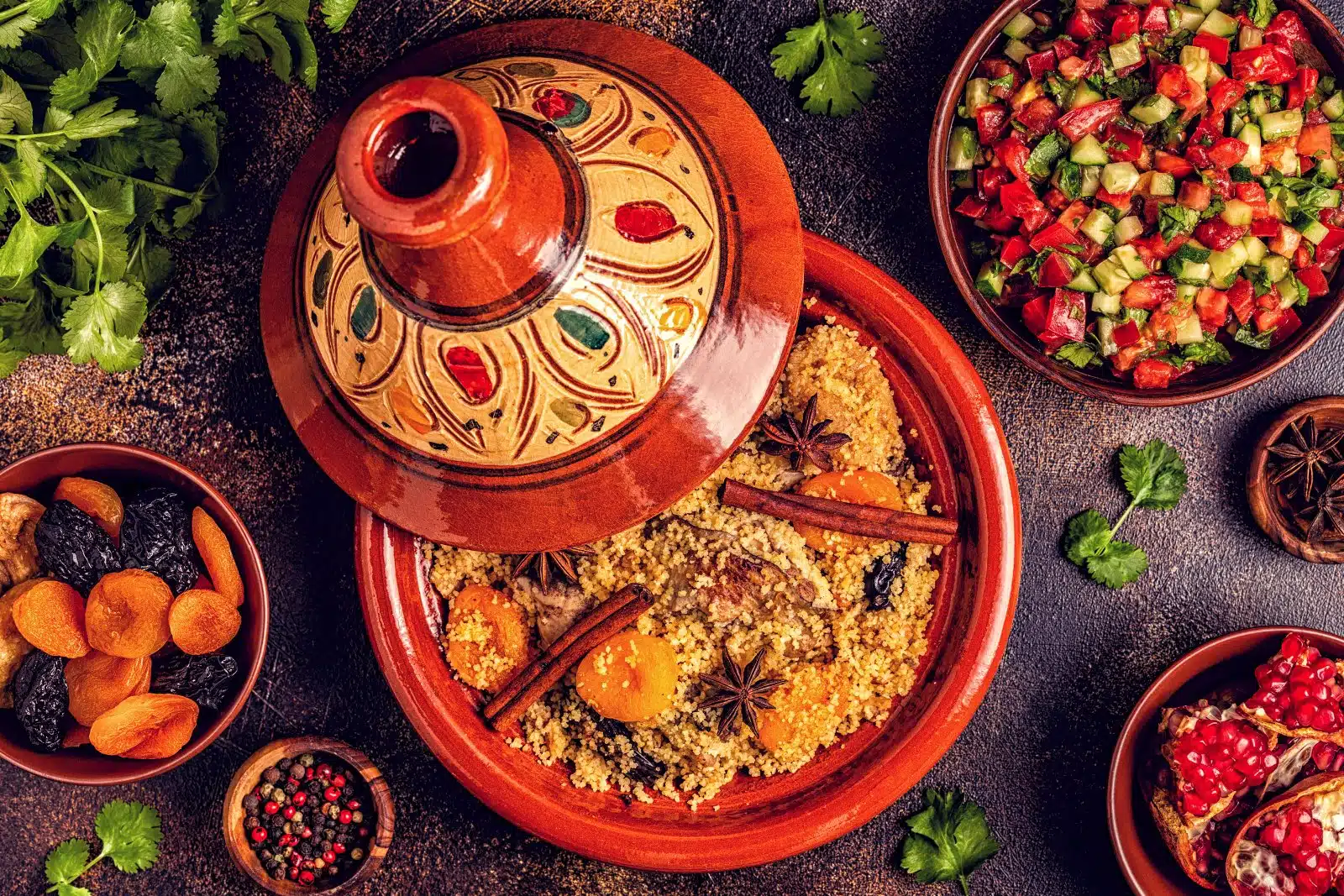
Image Credit: Shutterstock / Tatiana Bralnina
Moroccan cuisine, with rich flavors and diverse influences, is a feast. This culinary tradition, rooted in Berber, Arab, Andalusian, and Mediterranean cultures, offers a variety of dishes that reflect the country’s complex history and geography. Tagines, slow-cooked stews with meat and vegetables, and couscous, the national dish, are Moroccan dining stapled with spices like saffron, cumin, and cinnamon. The ritual of mint tea served with generosity and hospitality, symbolizes Moroccan warmth and welcome. Exploring Moroccan cuisine explores the country’s soul, where each meal embraces tradition, family, and the blending of cultures. Taking a cooking class or visiting a local market can provide insight into the ingredients and techniques that define Moroccan cooking, offering a deeper connection to the land and its people.
Insider’s Tip: For an authentic culinary experience, visit a local market to select fresh ingredients, then participate in a cooking class to learn the art of Moroccan cuisine.
When to Travel: Moroccan cuisine can be enjoyed year-round, but visiting during the harvest seasons (spring and autumn) can provide the freshest ingredients and flavors.
How to Get There: Cooking classes are offered in major cities and tourist destinations across Morocco, including Marrakech, Fes, and Essaouira.
9. Stay in a Traditional Riad
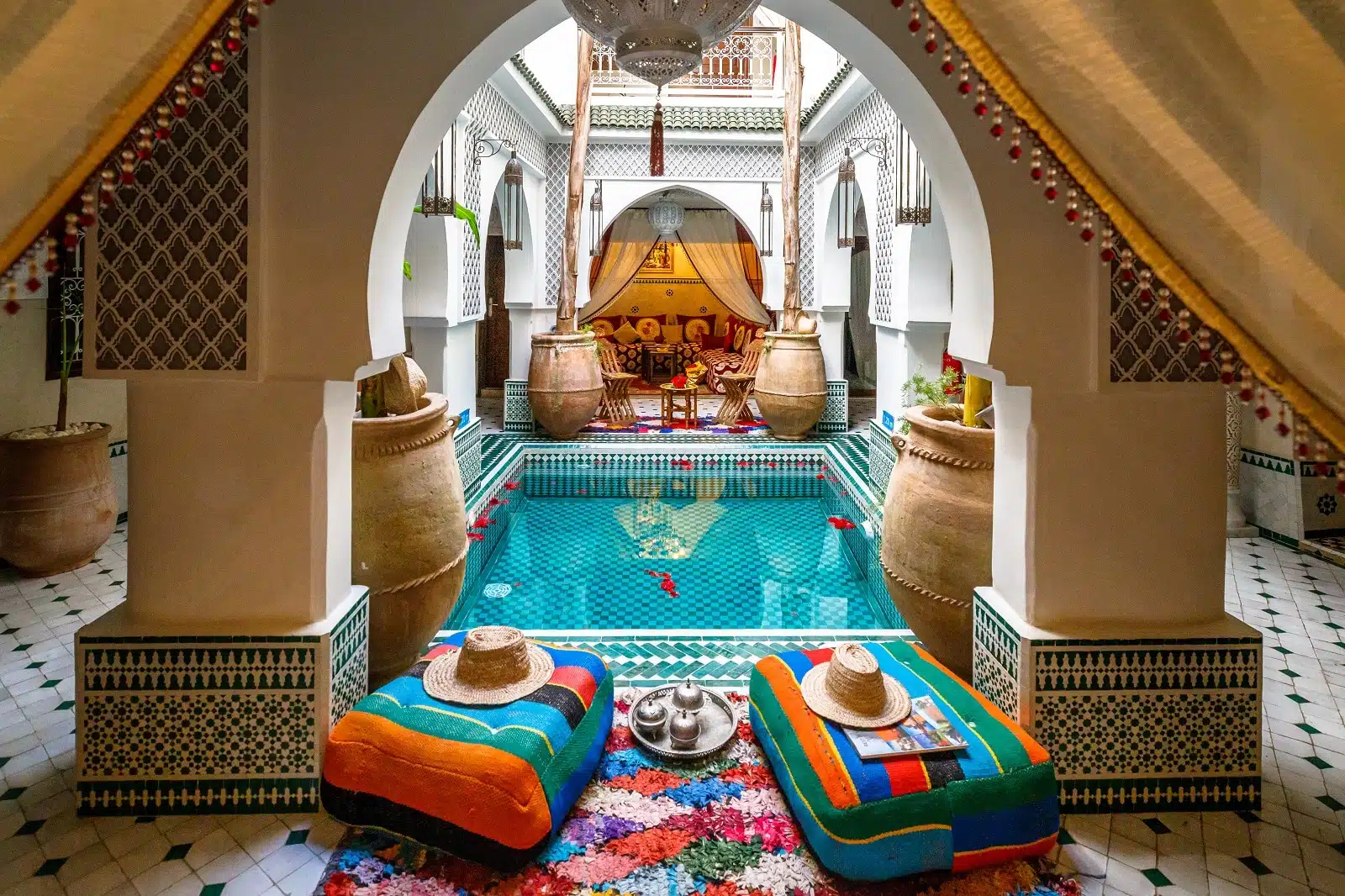
Image Credit: Shutterstock / ZCphotography
The traditional riad stands as a sanctuary of peace and architectural beauty in the heart of Morocco’s bustling medinas. These historic homes, centered around a serene courtyard or garden, offer a unique lodging experience that blends the rich heritage of Moroccan design with modern comforts. Characterized by intricate tile work, carved wooden doors, and lush gardens, riads provide an intimate glimpse into the Moroccan way of life. Many feature rooftop terraces, where guests can enjoy panoramic city skyline views or a quiet evening under the stars. The interior of each riad showcases Morocco’s craftsmanship, from the detailed plasterwork to the vibrant zellij (mosaic tiles) that adorn the walls and floors. Staying in a riad is an immersion into the culture, offering personalized hospitality that makes each guest feel like part of the family. The tranquil atmosphere contrasts the lively streets outside, offering a peaceful retreat where you can unwind after a day of exploration.
Insider’s Tip: Choose a riad that offers rooftop dining or a terrace view, allowing you to enjoy breakfast or tea with a panoramic view of the city.
When to Travel: Riads offer a charming experience year-round, but the spring (March to May) and fall (September to November) seasons offer the most comfortable climate for enjoying the outdoor spaces.
How to Get There: Riads are located in the heart of Morocco’s historic cities, including Marrakech, Fes, and Essaouira. They are usually accessible by foot or taxi from the main entry points of the cities.
10. Explore Casablanca’s Hassan II Mosque
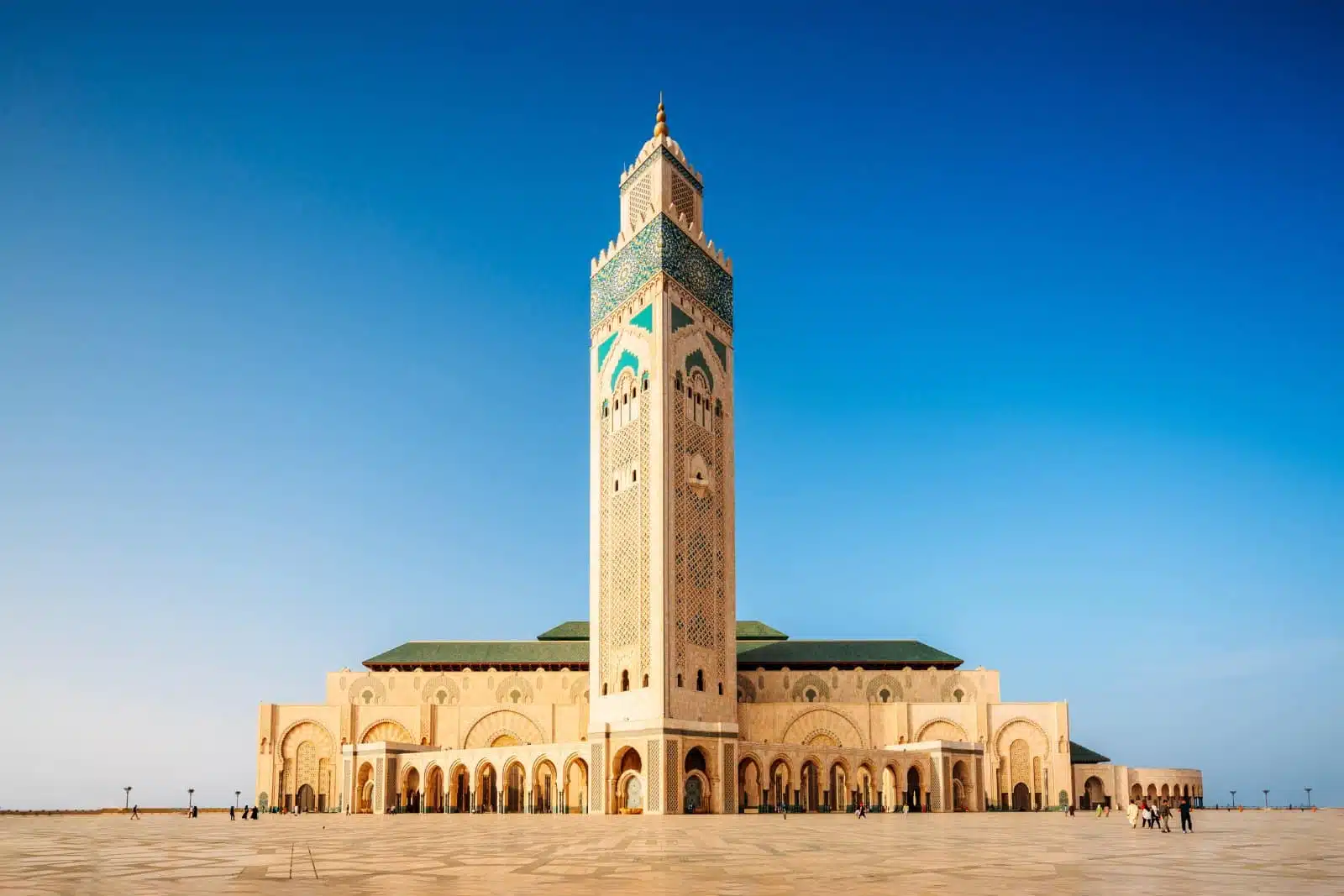
Image Credit: Shutterstock / HelloRF Zcool
Casablanca’s Hassan II Mosque is a religious site, a masterpiece of Moroccan craftsmanship, and one of the most breathtaking architectural wonders of the modern world. Perched on the edge of the Atlantic Ocean, its minaret towers above the city are the tallest in the world, serving as a beacon of Islamic art. The mosque’s vast prayer hall can accommodate over 25,000 worshippers, with the sea visible through a glass floor, creating a connection between faith and the natural world. The attention to detail in the mosque’s construction is unparalleled, from the hand-carved marble pieces to the intricate woodwork and vibrant mosaics that decorate its walls and ceilings. The facility also includes a museum, baths, a library, and a school, making it a center for religious and cultural education. Visiting the Hassan II Mosque offers insight into Morocco’s spiritual heart and its people’s artistic achievements. The guided tours available to non-Muslim visitors provide a rare opportunity to appreciate the interior of this architectural gem up close.
Insider’s Tip: Non-Muslim visitors are welcome to tour the mosque outside of prayer times through guided tours, offering a rare opportunity to appreciate the interior of this architectural masterpiece.
When to Travel: Casablanca can be visited year-round, but the mild weather in spring (March to May) and fall (September to November) makes these seasons ideal for exploring the city.
How to Get There: The Hassan II Mosque is located in Casablanca easily accessible by taxi or public transport from anywhere in the city.
11. Discover the Gardens of Marrakech
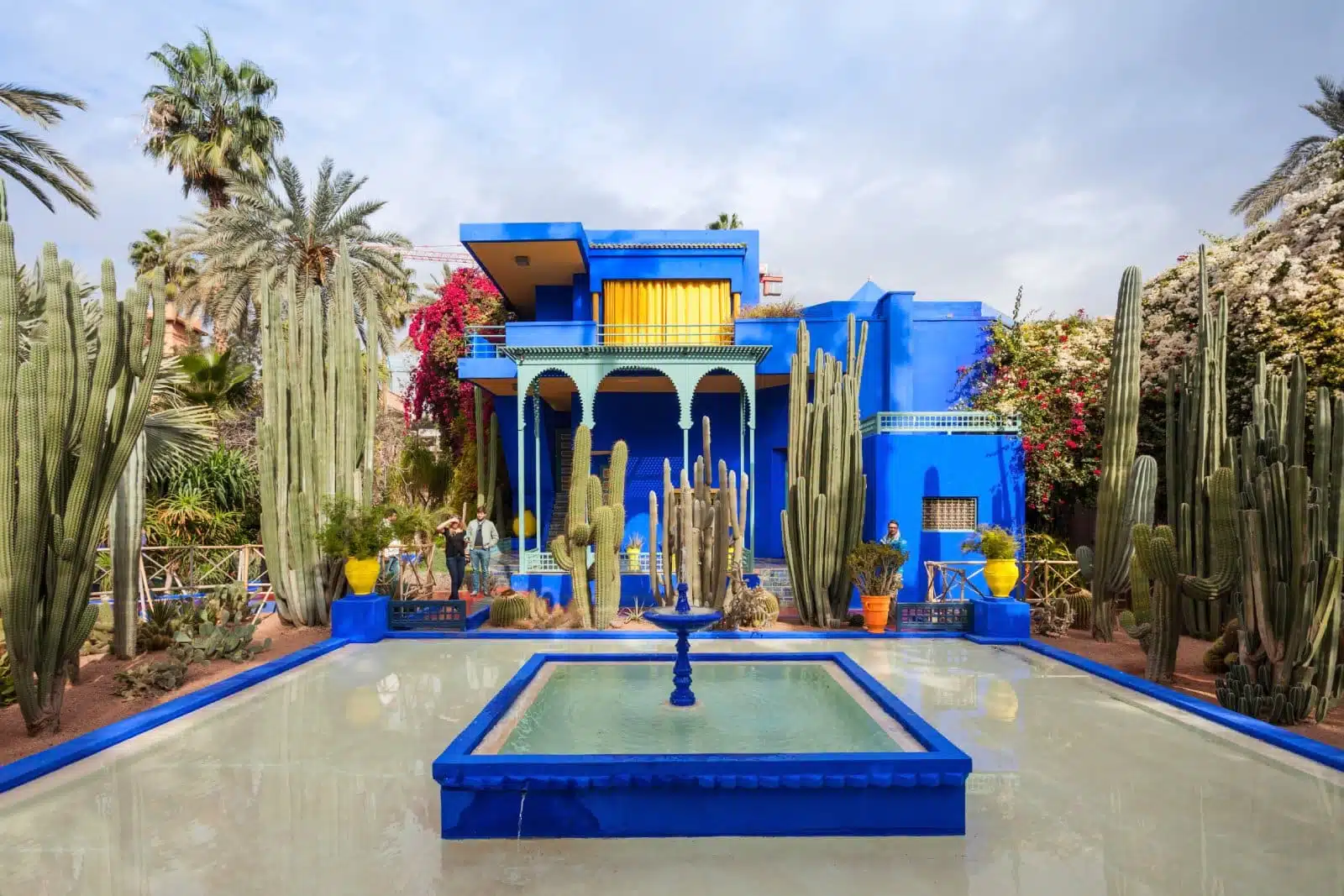
Image Credit: Shutterstock / saiko3p
Marrakech’s gardens are oases of calm and beauty amidst the city’s vibrant chaos. The Majorelle Garden, once the home of the French painter Jacques Majorelle and later restored by Yves Saint Laurent, is a living painting with bold cobalt blue accents against the lush greenery of exotic plants from across the globe. The garden’s paths invite strolls, leading visitors through a tranquil world of bamboo groves, lily-covered ponds, and vibrant floral displays. Similarly, the historic Menara and Agdal Gardens offer a glimpse into the royal past of Marrakech, with their vast olive groves and ancient irrigation systems reflecting the ingenuity of Moroccan garden design. These gardens provide a respite from the hustle and bustle of the city and showcase the importance of green spaces in Moroccan culture, serving as communal places for relaxation, reflection, and socializing. A visit to these gardens takes you through the art of Moroccan landscaping, where every element is carefully curated to create harmonious, serene environments that soothe the soul.
Insider’s Tip: Visit the Majorelle Garden early in the morning to avoid the crowds and experience the garden’s tranquility.
When to Travel: The gardens are beautiful year-round, but visiting in the spring (March to May) lets you see them fully bloom.
How to Get There: The gardens are located within Marrakech and are accessible by taxi or a short walk from the city center.
12. Shop in the Souks
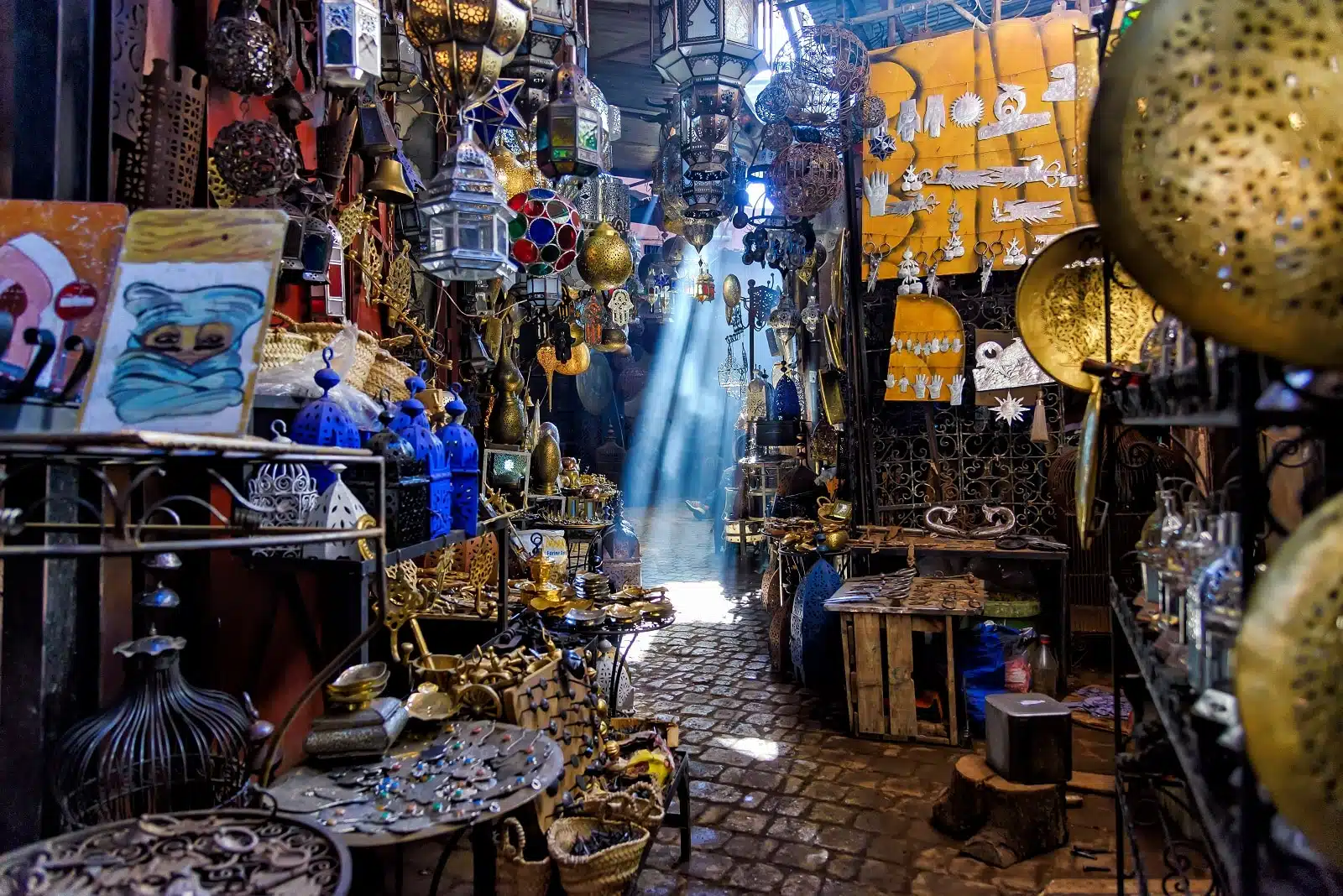
Image Credit: Shutterstock / Checco2
The souks of Morocco are a testament to the country’s rich mercantile history, offering a shopping experience that goes beyond mere transaction to become a cultural immersion. As you navigate through the narrow alleys lined with stalls and shops, you are in a world where every sense is engaged. The air is filled with the scent of spices, leather, and mint tea, while the vibrant colors of textiles, pottery, and lanterns catch the eye at every turn. The souks are the beating heart of Moroccan cities, where the art of bargaining is practiced with gusto, and shopping becomes a social activity. Artisans and craftsmen display their skills, creating everything from intricate jewelry to handwoven carpets, offering a glimpse into the traditions passed down through generations. Engaging with the shopkeepers allows you to learn the stories behind the items you purchase and provides insight into the Moroccan way of life. The souks offer an unparalleled opportunity to find unique treasures while experiencing the warmth and hospitality that define Moroccan culture.
Insider’s Tip: Bargaining is expected in the souks, so don’t hesitate to negotiate prices. Starting at about half the asking price is a common strategy.
When to Travel: The souks are open year-round, but visiting early or late afternoon can help avoid the peak crowds.
How to Get There: Souks are located in the medinas of Moroccan cities, with the most famous ones in Marrakech, Fes, and Essaouira, easily accessible on foot or by taxi.
13. Attend a Moroccan Festival

Image Credit: Shutterstock / iPortret
Morocco’s festivals are vibrant celebrations of its rich cultural tapestry, offering a window into its traditions, music, and communal spirit. From the spiritual sounds of the Fes Festival of World Sacred Music to the colorful spectacle of the Marrakech Popular Arts Festival, each event is an opportunity to experience Morocco’s diverse cultural heritage. The Gnaoua World Music Festival in Essaouira brings together musicians from around the world, celebrating the Gnaoua music tradition and its African roots. Meanwhile, the Rose Festival in El Kelaa M’Gouna honors the harvest of the Damask rose, filling the air with fragrance and the streets with parades. Attending a Moroccan festival allows you to immerse yourself in the joy and creativity of Moroccan society, where music, dance, and celebration are integral to the fabric of life.
Insider’s Tip: Plan your visit around the festival dates you wish to attend, and book accommodations well in advance, as these events can draw large crowds.
When to Travel: Festival dates vary, but they are often held in spring and fall, aligning with the agricultural calendar and religious observances.
How to Get There: Essaouira and El Kelaa M’Gouna are accessible by bus or car from major cities like Marrakech and Casablanca. Check the festival schedules and transportation options in advance.
14. Visit the Ouzoud Waterfalls
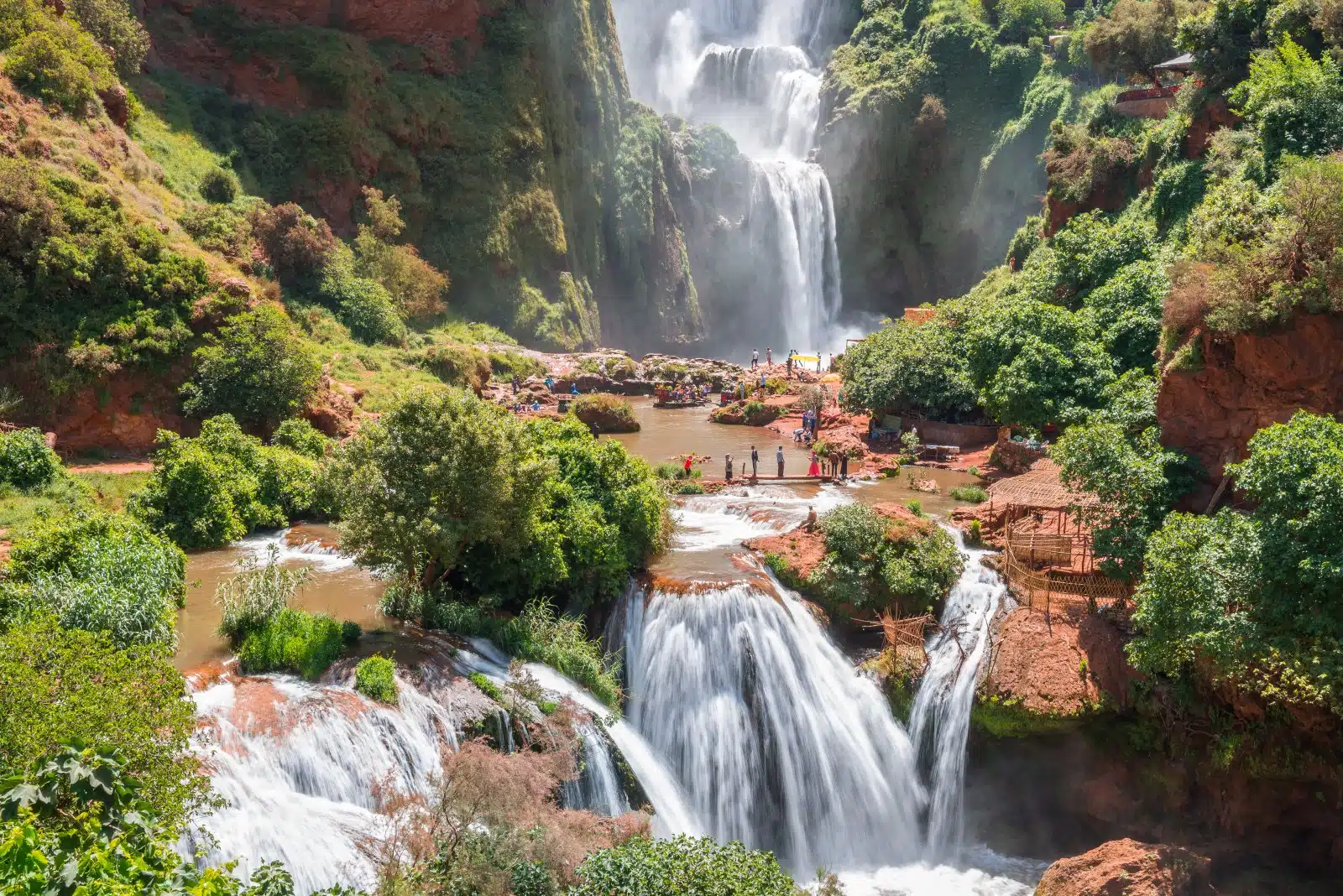
Image Credit: Shutterstock / Alberto Loyo
The Ouzoud Waterfalls in the Middle Atlas region are among Morocco’s most stunning natural wonders. Cascading over 110 meters into a lush gorge, these waterfalls create a serene and picturesque setting that attracts nature lovers and photographers alike. The journey to the falls, through olive groves and rugged terrain, is an adventure. At the base, you can swim in the natural pools or take a boat ride to get closer to the thundering water. The area is also home to Barbary macaques, adding a unique wildlife encounter to the experience. The Ouzoud Waterfalls offer a refreshing escape from the heat and a chance to connect with Morocco’s natural beauty.
Insider’s Tip: Take a guided hike to explore the surrounding area and learn about the local flora and fauna. Don’t forget to enjoy a traditional Moroccan meal at one of the nearby restaurants overlooking the falls.
When to Travel: The waterfalls are most impressive in the spring (March to May) when the winter snows are melting, but they also offer a refreshing escape from the heat in the summer months.
How to Get There: The Ouzoud Waterfalls are about a 2.5-hour drive from Marrakech. They can be visited on a day trip by bus, private car, or guided tour.
15. Explore the Imperial Cities
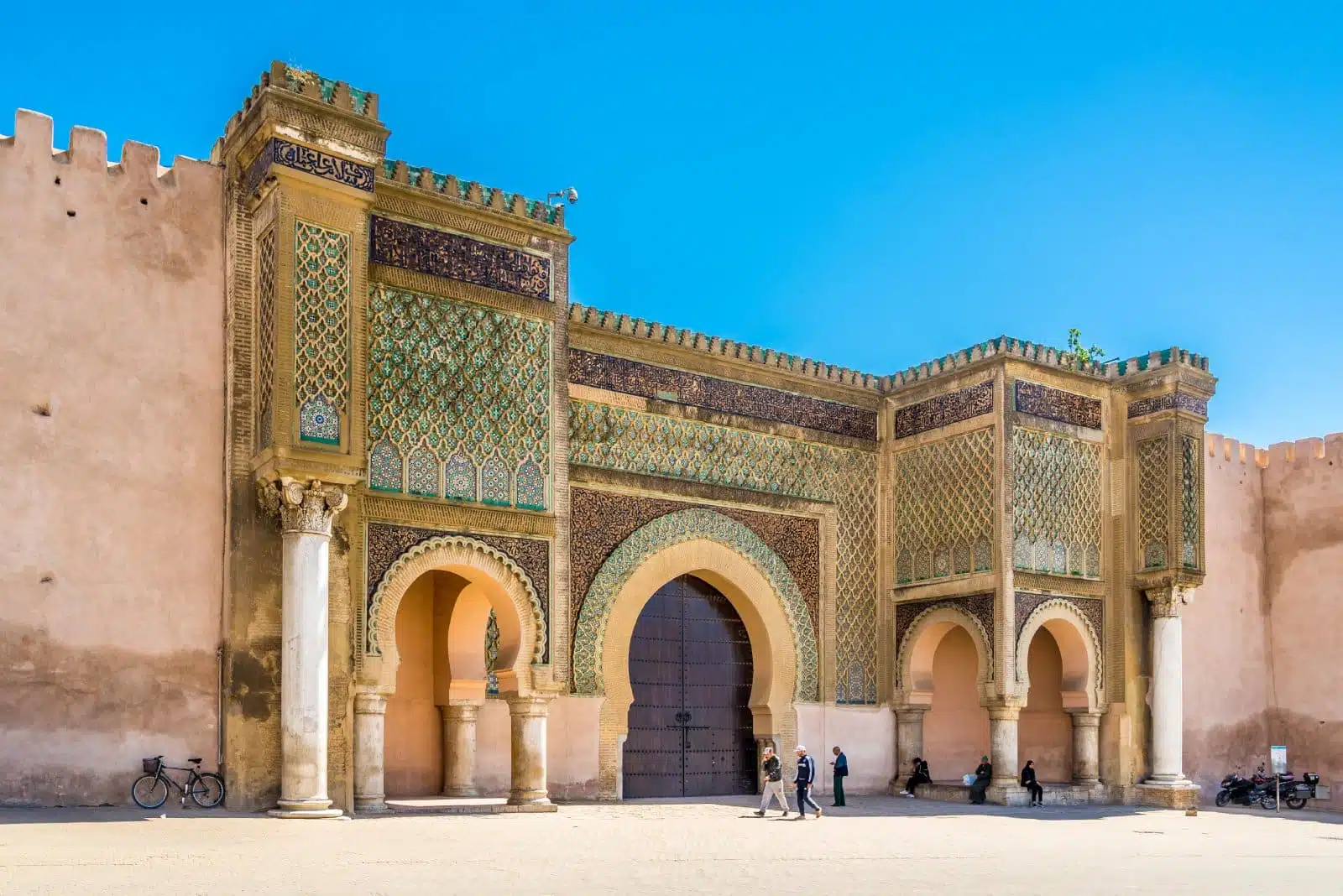
Image Credit: Shutterstock / milosk50
Morocco’s imperial cities, Marrakech, Fes, Meknes, and Rabat, are part of the country’s historical and cultural identity. Each city, once the capital of the kingdom, boasts a unique blend of architectural marvels, historic sites, and vibrant medinas that tell the story of Morocco’s dynastic past. With its lively Jemaa el-Fnaa square and majestic palaces, Marrakech is a sensory overload. Fes, known for its scholarly and spiritual heritage, houses the ancient Al-Qarawiyyin University. Meknes, with its grandiose gates and palaces, reflects the ambition of Sultan Moulay Ismail. Rabat, the current capital, offers a more relaxed atmosphere with its coastal setting and modernist architecture. Exploring these cities provides a journey through time, where the splendors of Morocco’s imperial past meet the dynamism of its present, offering endless discoveries for the curious traveler.
Insider’s Tip: Each city has its own version of a medina and royal palace. Take the time to explore these with a guide to understand each location’s historical and cultural significance.
When to Travel: The imperial cities can be visited year-round, but the spring (March to May) and fall (September to November) offer the most pleasant weather for exploring.
How to Get There: The imperial cities are well-connected by train and bus routes, making them easily accessible from major entry points like Casablanca and Tangier.
The Bottom Line
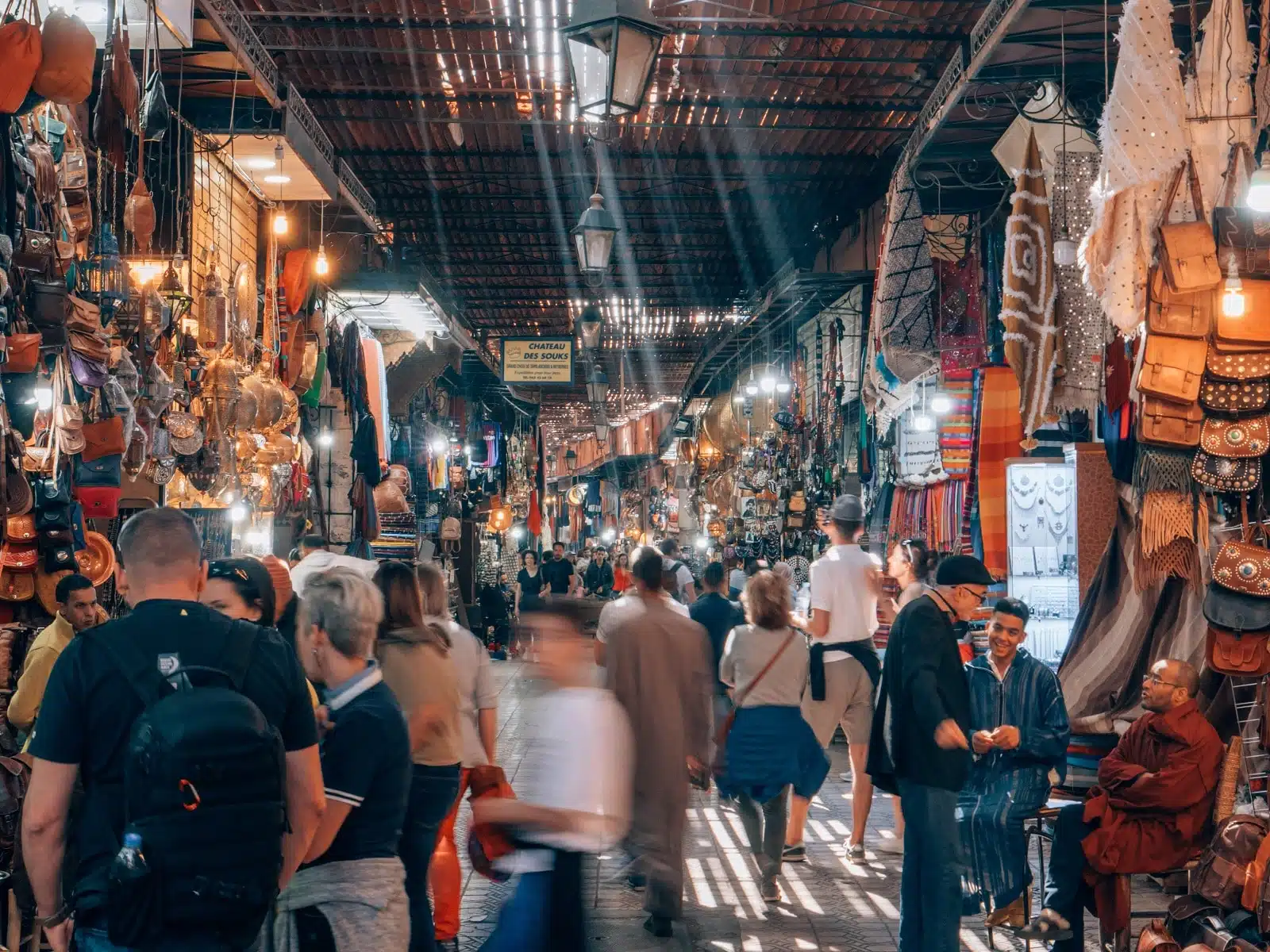
Image Credit: Shutterstock / SmallWorldProduction
Morocco is a land of endless discovery, where ancient cities and natural wonders tell the story of a country at the crossroads of Africa and Europe. From the lively festivals celebrating its cultural diversity to the serene beauty of its natural landscapes, Morocco offers a journey through time and tradition. As you explore the imperial cities, navigate the bustling souks, and relax in the tranquil gardens, you’ll find that Morocco’s true beauty lies in its ability to blend the old with the new, creating a tapestry that is as vibrant and diverse as the people who call it home. Whether seeking adventure, relaxation, or cultural immersion, Morocco promises an experience that captivates your heart and enriches your spirit.
More From The Green Voyage
Top 10 Trending Travel Destinations 2024
6 Essential Banking Apps for International Travel – Managing Your Finances on the Go
Traveling With Kids – 10 Tips to Create Memorable Family Holidays
The post A County Guide to Morocco first appeared on The Green Voyage.
Featured Image Credit: Shutterstock / kudla.
For transparency, this content was partly developed with AI assistance and carefully curated by an experienced editor to be informative and ensure accuracy.
Tips for Trip Success
Book Your Flight
Find an inexpensive flight by using Kayak, a favorite of ours because it regularly returns less expensive flight options from a variety of airlines.
Book Your Hotel or Special Accommodation
We are big fans of Booking.com. We like their review system and photos. If we want to see more reviews and additional booking options, we go to Expedia.
You Need Travel Insurance!
Good travel insurance means having total peace of mind. Travel insurance protects you when your medical insurance often will not and better than what you get from your credit card. It will provide comprehensive coverage should you need medical treatment or return to the United States, compensation for trip interruption, baggage loss, and other situations.Find the Perfect Insurance Plan for Your Trip
